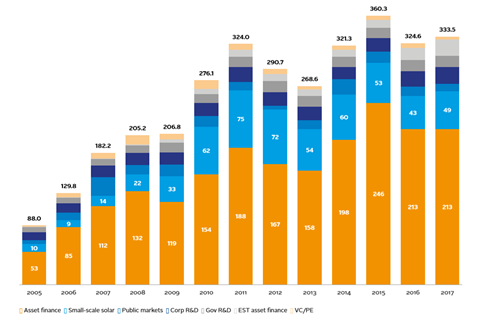While the public markets comprise a smaller portion of the clean energy investment universe compared to asset finance and unlisted assets (including infrastructure, private equity and venture capital), activity in the acquisitions market has steadily grown over recent decades, reflecting the larger size of the renewable energy sector (see below).

Approaches
As with managing broader ESG and sustainability issues, there are a number of approaches for aligning a fund with climate-related investment objectives.
- Negative screening overlay: The investment process generally remains the same, but the opportunity set is narrowed to remove certain (i.e. high CO2-emitting) companies from the investment universe (similar to the approaches described in constructing lower carbon indices).
This might appeal to investors that seek to exclude fossil fuel-related companies from their portfolios and clearly demonstrate this commitment to their constituents.
- Best in class: The active manager underweights the higher CO2-emitting/less climate-aware companies and overweight the less CO2-emitting/more climate-aware companies versus a standard benchmark. These funds tend to use a scoring system or proprietary model and, to varying degrees, will adopt a rules-based approach to portfolio construction to ensure that a certain outcome is achieved in terms of emissions reduction and/or climate resilience.
This might appeal to investors that want to avoid the higher emitting companies but also capture the leaders in the low-carbon transition process, and have these goals made explicit as part of the portfolio management process.
- Integration into valuations: This involves strategies that have an investment process that incorporates climate-related risks and opportunities into the bottomup (and top-down) assessment of companies and portfolio construction. These strategies are less likely to have an explicit label or low-carbon investment theme, but rather will seek to manage climate-related impacts as an integrated part of the valuation and engagement process.
This might appeal to investors that believe in active management and the need for unconstrained portfolio mandates, but want their values and beliefs on being broadly positioned for the low-carbon transition process to be aligned with the investment manager’s actions.
- Thematic funds: Strategies that explicitly focus on lowcarbon, or climate-alignment investment sectors and themes, such as lower emissions, resource efficiency, water efficiency, waste management, renewable energy/technology and energy efficiency12. Such approaches may be less diversified than broader equity funds that take an integrated approach, depending on how narrowly defined the climate-related theme is and the sector exposure implications. The benchmark is likely to be more constrained and the portfolio risk more concentrated, but it will be easier to demonstrate clear and positive links to achieving specific climaterelated outcomes.
This might appeal to investors that have advanced their approach towards managing climate-related risks and opportunities, and would like to explicitly focus on specific low-carbon themes as part of the low-carbon transition process. They will also seek to clearly demonstrate and report positive climaterelated benefits and outcomes to their constituents.
Investment characteristics
While the investment characteristics of broader ESG/ sustainable, climate-aligned equity strategies are largely dependent on the approach that the funds take (negative screening, best in class, integration and/or thematic), some of the typical investment characteristics of ESG/sustainable strategies that include climate-alignment elements are summarised below.
Investment characteristics of sustainable, climate-aligned equity strategies
| Investment objectives | “Generate long-term investment returns that seek to capture the low-carbon transition process” |
|---|---|
| Investment horizon | Five+ years |
| Regions | Global, reflecting country weights of global equity indices |
| Benchmarks | Standard benchmarks apply (negative screening likely to use excl.-fossil fuels indices) |
| Fees | Typical of other actively managed equity funds; may be slightly higher depending on the degree of tailoring required |
| Number of holdings | >60 for global funds |
| Sectors | Aim to minimise sector bias to a comparable (unconstrained) benchmark |
| Risk indicators | Most funds assess the risks at 6 on a scale of from 1 (low) to 7 (high) |
| Link to mitigation of climate-related risks and capturing new opportunities | Potential to reduce exposure to fossil fuels and carbon intensive businesses, while investing in companies that are less emission intensive and better positioned to benefit from the low-carbon transition. The outcome is highly dependent on the mandate definition (and approach taken) as well as the skill of the active fund managers |
Examples
- The California State Teachers’ Retirement System (CalSTRS) approves equity fund managers to receive up to US$1 billion for ESG-related mandates. CalSTRS’ ESG investment programme includes considering climate-related impacts and is likely to have positive outcomes in terms of low-carbon and energy efficiency progress, although the mandates have been defined more broadly as ESG-focused.
- French public sector pension fund ERAFP plans to invest €50 million into international equity funds aimed at combating climate change. The fund has been using a best-in-class approach to socially responsible investment for a number of years and announced in 2017 an extension to this program, with the allocation of capital to investment solutions that “meet the challenge of combating climate change”. The fund developed a virtual management platform to enable the managers to demonstrate their low-carbon management expertise.
- New York State Common Retirement Fund invests US$3 billion in ESG and sustainable investment equity funds. The fund allocated assets to global equity sustainability mandates that incorporate ESG and sustainability criteria as a core part of the investment process, including climate-related risks and opportunities.

How to invest in the low-carbon economy
- 1
- 2
- 3
 Currently reading
Currently readingListed equity funds
- 4
- 5
- 6
- 7
- 8


















